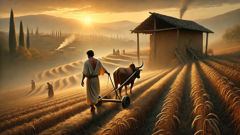Introduction
The mountains keep their stories in the creak of pines and the hollow of limestone where water has learned patience. In those heights, where human voice grows thin and the sky leans close, dwell the Oreads—nymphs born of stone and wind, of snow and the slow exhale of earth. They are not mere sprites for a child's comfort; they are the contours of a landscape given breath, a fragile chorus that names the gullies, the hidden grottoes, and the ravines where light comes to rest. People of ancient valleys learned to leave thanks in clefts, to hang strips of cloth upon scrub oak and to whisper before ascending paths, for the Oreads listen. They are kin of Artemis in ways that are both obvious and subtle: protectors of wild places, hunters of disturbance, attendants to the silver goddess who moves like a rumor through the trees. Yet their legend is not a single melody but a braided song of origin, hunger, bargain, and mourning. In winter they are ice-made and slow; in spring they spill like thawed water, impatient to re-sculpt the cliffs with seed and root. Their grottoes harbor oils and bones, votive pebbles and shells carried up from the shore by those who once sought to bind sea and mountain. This tale folds together the beginnings of the Oreads, the pacts forged with Artemis and mortals, the rites left on stones, and the small cruelties and kindnesses that alter a slope for generations. It is a story meant to be read slowly, as one would ascend a ridge—watching for fox tracks, listening for a sudden hush that might mean a nymph has paused, listening for a voice that is older than memory and more intimate than law.
Birth of the Oreads and the Shape of Their Realm
Long before villages traced terraces upon slopes and before shepherds learned the rhythm of goat bells, the mountains had their own law—one of slow processes and sudden reckonings. The first Oreads, so the older songs claim, were born from small violences: a boulder splitting under frost, a seam of mineral giving way to a hidden spring, a hawk's talon scraping at an exposed ledge. In those beginnings there is both accident and personhood; terrain breaks and then feels its break, and in that feeling something like consciousness gathers. These early Oreads were less like the lithe maidens later pictured and more like the mountain itself—broad-shouldered, covered in lichen and hair of trailing roots. They learned to move across the rock in the only way the mountain had taught them: slowly, with purpose, shaping a known path into a memory.

From these origins arose their relationship to water and stone. Where capillary springs took form from the crushed rock, an Oread might stand so still that a thin veil of mist condensed at her feet. The organisms that lived in that mist shifted as if in a new climate. Seeds that could not otherwise find purchase took root in maternal crannies. Thus the Oreads were midwives of ecologies, guardians of fragile pockets where life refused to follow the wide rules of the plain. Grottoes—liminal, cool, and secret—were their chambers. They kept votive pebbles and rings left by passing humans, and they kept names. To call a ravine by its proper name was to renew it; a name given and sung across a few generations anchored streams against drought in the way an oath anchors a soul. Because of this, their anger could be practical—if a path were cut and a spring diverted, an Oread might close her grotto and the fog would stop condensing; reed and fern would wither along a known bank.
They learned the movements of animals intimately. The Oreads did not merely watch deer; they taught how to read hoof prints under snow, how to find shelter where the wind fell away, which handfuls of lichen were safe to eat and which would steal life from a goat's body. In return, herds left tithes—hair caught on a thorn, hooves scorched gently into a rock for luck. But their economy with animals was not barter alone; it was a jurisprudence where the mountain's appetite and the meadow's fertility were adjudicated by the Oreads' whims. If a hunter exsanguinated a slope, taking more than he returned, the Oreads would answer by making birch roots tangle his path or by shifting a boulder so the trail forked into wrong direction until he grew thin and contrite.
Their connection to Artemis comes as a second genesis: the goddess who walks with bow and moon is structural to the Oreads' identity. Artemis is not merely an ally but a model and protector—she is the one who moves freely across the boundary of animal and human, who honors the chase yet also insists on divine restraint. To the ancient communities, Artemis's favor meant a season without blight, a birthing that did not die in the groin of winter, a pack that returned. To the Oreads, Artemis was kin: she walks without owning, she kills and spares with equal seriousness, and she recognizes the sanctity of a wild place. Many stories suggest that the first of the Oreads were handmaidens lost on a hunt who chose stone over marriage to the plain; others say Artemis breathed a name into the wind and the mountain answered. Either way, the goddess's covenant with the Oreads involved a reciprocity: Artemis's hunters would not despoil sacred groves if rituals were kept, and the nymphs would guide the goddess's path and whisper warnings when a human sought to hollow the mountain for profit.
This reciprocity produced customs. At the high passes, villagers learned to leave small altars of unworked stone—simple cairns draped with sprigs of juniper. Women on the eve of birth would walk those passes to ask the Oreads for a safe delivery, singing a low chant not quite remembered in later songs. Hunters would not call their quarry by the mountain's sacred names; they spoke of it as 'the shadow' or 'the wind' when they meant to take what the mountain allowed. These linguistic evasions are pragmatic: to directly name is to stake a claim, and to claim is to risk a counterclaim from the Oreads themselves. Many of these customs have tactile traces—pebble piles oriented toward grotto mouths, cloths knotted low on oak branches by ravine edges—small legal markers in a landscape where law emanated from the living shape of the land itself.
Yet the Oreads could be generous in ways that complicate the binary of wild and kind. In the wake of drought, they might reroute a spring to the slope where a village's cistern had cracked; their gift looked miraculous but came with expectation: that the people's children would not trudge to the upland to scar a sacred bank, that they would leave bread and water on a stone as thanks at the year's end. These obligations formed the lattice of an ancient environmental ethic: give and do not take without ceremony. Breach the covenant and the mountain enacts slow punishments—lost goats, calves born limbless, fruit trees that fail to set. The Oreads' approach was never simply to kill. Rather, they altered the conditions of survival until the human community learned to mourn and adjust. In this sense, the Oreads were patient teachers, their scorched thirsts and sudden gifts functioning like the mountain's long memory.
They were not immune to time. As settlements grew and the need for more cultivated land became urgent, terraces chipped away at the slopes in ways older songs call 'the lancing of a thigh.' Quarrying for stone and the digging of deep channels for irrigation were breaches the Oreads felt as bleedings. The more humans learned to force the mountain into the shape of yield, the more the nymphs receded into ever narrower fissures. Where once groves spread into broad caverns, the Oreads retreated into secret pockets where sound of hammering did not reach. In those pockets they preserved archives—mosses laid like pages, lichens that mapped weather across generations, and collections of tokens: an amphora rim, a child's carved toy, a hunter's lost pendant. Those items, layered and dusted with mineral drips, served both as memory and as evidence of human transgression or devotion. When a people repented, the Oreads might surface more openly again, allowing paths to re-stabilize and springs to be generous. When a people grew proud and careless, the mountain's guardians would close and wait, and the ache would be felt for generations that followed.
There are also darker strains in their births. Some Oreads are said to be wrathful forms—spawned from lands steeped in blood where hunts turned into massacres, where armies marched and the mountains drank their iron. These Oreads are not kindly teachers but sentences: avalanches that do not spare, fog that disorients and sends travelers into crevasses. They are stories told to children as warnings and told in earnest at funerals to remind survivors that the memory of violence is not erased by time. In the cluster of myths across Greece, such Oreads function as ethical barometers; their return indicates a violated covenant and insists on a reparation ritual that tends to be arduous, communal, and precise. The adjacency of kindness and wrath within the Oreads' nature is what made them compelling to ancient peoples: the gods and the wild are not univocal. To survive beside such beings required literacy of the landscape and humility before processes larger than human intention.
Thus the first order of their world is patience, and the second is naming. The mountain teaches endurance, the Oreads teach care, and Artemis—the goddess of liminality—teaches balance. The songs left behind by those who lived long among slopes are not just catalogues of fancy but codified observations, an environmental conscience disguised as myth. Those songs keep the Oreads alive in memory, and memory keeps them alive in possibility: where a cliff is recollected as a place of song and restraint, it is less likely to be pulverized by greed. The Oreads ask only that people pay attention and that they accept the stubborn wildness that refuses to be fully domesticated.
Encounters with Mortals, Rites, and the Artemis Covenant
Human lives along mountain margins are braided with ritual from necessity. Weather can wreck a harvest in an afternoon, and a single misstep can cost a life. In such conditions, stories acquire urgency; they are protocols as much as entertainment. The Oreads' interactions with mortals fit this pattern—myths that serve as instruction manuals for living in places that demand respect. Many of the more persistent tales are small and granular: how a woman should approach a grotto to ask for fertility, how a young man might seek guidance on a hunting path without incurring the Oreads' ire, how communities reconfigured their calendars to walk a particular pass on the day the moon first rises over a favored ridge.

The rites vary by region and by the temper of the local Oreads. In a valley where limestone forms shallow caves and spring water tastes faintly of iron, offerings tended toward metalwork—old nails and thin coin fragments hammered into a shallow recess. In granite-scarred ranges where moss is rare, offerings became fragrant: pressed herbs, a marrow of goat, bread dried and crumbled. Some rites required movement: the petitioner would circle a boulder three times clockwise and then once counterclockwise, humming a tune whose melody matched the contour of the ravine. The sound was supposed to wake the Oreads gently, to remind them by cadence that a person approached in humility. These rituals often required a mediator—an elder woman, a shepherd with a lineage of watchers, an initiated hunter. Mediators knew which names to avoid and which to speak; they knew the old cadence that soothed and the second cadence that warned.
There is a famous set of narratives often called the Covenant Tales. They revolve around a simple pact struck at a cleft where three streams converge: the Oreads promised safe passage and generous seasons if the humans agreed to three terms. First, no quarry greater than a small deer would be taken from sacred groves; second, no stone would be quarried from the immediate cleft without a communal offering; third, a token of thanks—a ribbon or a bowl—would be left at the cleft's mouth each solstice. For generations the covenant held. Families who honored the rites prospered sufficiently; children learned to find sweet water without sinking wells too deep. Then came a time of pressure: a string of poor harvests led a village to demand more land. A new leader, impatient and proud, ordered men to hack a terrace into the sacred cleft. At first nothing happened. Stone fell, and the village had immediate food. But then the rains that usually came at harvest twisted into violent torrents that rerouted into the terraces, undermining foundations and carrying topsoil away. The leader's house collapsed in a night of mud, and the people who had broken terms found themselves enduring a winter of scarcity. In the telling, the Oreads did not strike directly. They shifted the mountain's hydrology in ways difficult to reverse, and the community learned—painfully—that the covenant included consequences embedded in the landscape itself.
Artemis plays a singular role in mediating these consequences. She is often portrayed as a goddess who tolerates human supplication when it is humble and ritualized but reviles it when it becomes pride. In several tales a hunter boasts before taking more than his due, and Artemis appears, not as a wrathful deity but as a presiding figure who offers the offender a choice: give back what was taken or lose the capacity to hunt at all. These moral architecture stories functioned as checks for human greed: mortal overreach needed more than human law to be curbed because the effects were ecological and long-term. Hunters who returned ill-gotten trophies would find their packs failing them; those who restored gifts to the cleft found their nets mended themselves, as if invisible hands had woven the broken cords anew.
There are also tender accounts of reciprocity. In one village, a child with a crippled foot was taken into the ravine where Oreads were said to frequent. The family left food and a token, but the ritual required more: the child's mother remained by the grotto through the night, singing lullabies that called to both child and stone. At dawn the child's foot was lighter; not wholly healed, but enough to walk without pain. The people called this the Oread's touch, a mercy given because the family had tended the mountain reliably across seasons. The story becomes a lesson about long-term relationship building: reparation and respect, performed over generations, cultivate good will in the nonhuman world.
Not all agreements were grateful or straightforward. Sometimes bargains turned into bargains of blood and impossible cost. One ancient tale tells of a shepherd who struck a desperate pact with a particularly capricious Oread. His flock was infected; his family faced starvation. The Oread demanded the shepherd's voice—the shepherd's ability to call sheep and children—until the flocks were done and balance restored. The man agreed. He saved his flock, but afterward his voice was gone: he could not sing to his children or call goats down the path. He learned new ways to live—writing marks on stones, tapping rhythms on fenceposts—but the loss was profound. The tale is less a warning against bargaining per se and more a meditation on tradeoffs. Some favors require what the ancients called 'parting with a part of oneself,' an idea echoed across cultures when bargains with the wild demand a cost that is not monetary but deeply personal.
The intersection of human religion and Oread sanctity produced hybrid rites. At shrines where a small temple to Artemis stood on the edge of a ravine, both human priests and Oread-handmaidens were imagined to perform a ritual duet. The priests offered libations of watered wine and cast barley; the Oreads answered with crackles of falling pebbles and a breeze that rearranged prayer ribbons. In these rituals the line between divine and natural blurred: the goddess might receive the offering but the mountain would decide its efficacy. The effect was a distributed agency—the human practiced rites, the goddess sanctioned, and the Oreads ensured the land responded. The synergy of human and nymph gave rise to a cultural script: do not ask the goddess alone; attend also to the place where she walks.
As trade and conquest advanced, such hybrid places became vulnerable. Road-builders and armies needed stone and routes; they leveled sacred groves for the sake of straight lines and efficiency. The Oreads, when pushed, adapted by becoming more subtle or by withdrawing into memory. Some became names only, preserved in songs sung at hearths; others vanished entirely, leaving behind empty grottoes where votive pebbles gathered dust like unread notes. Yet even in loss, their influence persisted. Language retained their names; landscape features continued to be avoided; morbidity patterns were attributed to disgraced Oreads. In some cases, new religious forms borrowed their ethics: later temples and Christian hermitages that appear in these same ravines adopt a companionable sense of humility toward the land, reflecting a deep cultural continuity that outlived particular deities.
The Oreads' presence in modern mythic imagination is instructive. For contemporary readers steeped in environmental crisis, their stories offer an ancient framework for thinking about stewardship. The Oreads do not promise unending bounty; they offer balance, reciprocity, and a warning that extraction without return breeds ruin. Unlike a deus ex machina, they are not omnipotent arbiters who can fix a climate altered by empire; rather, they are local guardians whose protections are meaningful where communities cultivate long-term attention and care. In that sense, their tales read like proto-ecological texts—pragmatic guidelines embroidered as myth—insisting upon rituals that are less about superstition and more about deliberate, repeated acts of attention.
Finally, there are narratives that remain stubbornly ambiguous—stories where the Oreads and humans part with neither reconciliation nor catastrophe. In a handful of oral traditions, a single Oread falls in love with a human cartographer, not to be possessed but to learn the ways of naming from him. She teaches him the hidden names of springs and ledges; he teaches her the art of draft and ink. They exchange knowledge and then, at the edge of winter, they choose differently: he returns to the valley; she remains at the grotto. There is no punishment, no reward—only a leftover ribbon that flutters against a stone where a map once lay. Such stories suggest that coexistence can be ordinary, delicate, and partial, and that the most vital thing humans can do is to leave evidence of their care where it can be read by the next generation of listeners.
Across these narratives, the Oreads remain less like characters locked into a tidy moral and more like a dialect of nature itself—complex, contradictory, and ethically rigorous in ways that often outstrip immediate human comprehension. The rites people performed were not superstitious relics but social technologies designed to maintain a livable equilibrium. Artemis's covenant with them amplifies this ethic, joining human governance to a set of nonhuman rules that make sense only to those willing to attend. In the end, the Oreads teach a stubborn humility: that the land is a social partner, that names and small rituals matter, and that when culture respects place, it preserves a chorus of life that both nurtures and reproves.
Conclusion
To speak of the Oreads is to learn a grammar of landscape: to know where to step, where to leave a stone, when to speak a name and when to hold silence. Their legends endure because they encode a wisdom both pragmatic and poetic—teachings about limiting appetite, honoring place, and building long-term relationships with environments that can heal or harm depending on human behavior. They are neither wholly benevolent nor simply punitive; they oscillate between generosity and sternness in ways that reward attention and punish arrogance. Their bond with Artemis adds a moral clarity: the goddess's presence insists on restraint and recognition of the wild as something to be tended rather than owned. As modern readers, we can read these myths as environmental parables but also as cultural artifacts that reveal how ancient peoples negotiated survival. The offerings left by shepherds and the rites sung by mothers are not quaint relics; they are echoes of systems that once balanced human needs with the mountain's endurance. If the Oreads teach us anything now, it is that reciprocity is a practice, not a one-time contract. Ritual, named place, and small acts of restitution shape the conditions of future life in ways that compound over generations. In listening to their stories, we may discover inherited ethics that still matter: to pause at a ravine's lip, to say a name aloud and then leave a token, to match extraction with restoration. The mountain's memory is long; our choices echo in rock and water. The Oreads, patient as stone and mercurial as mist, wait and watch, offering their ancient covenant to any who will honor it.













